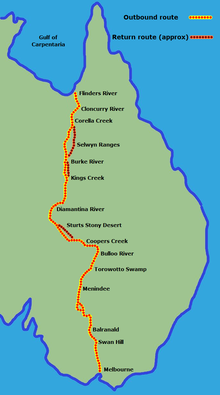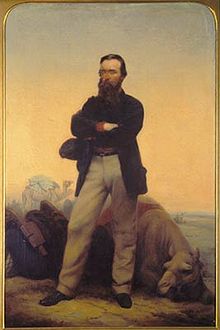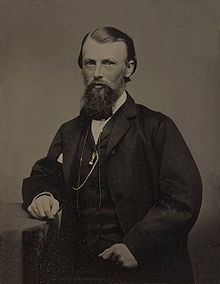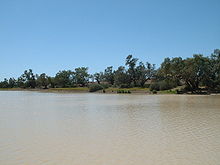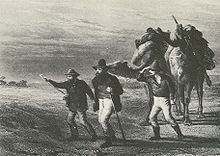- Burke and Wills expedition
-
In 1860–61, Robert O'Hara Burke and William John Wills led an expedition of 19 men with the intention of crossing Australia from Melbourne in the south to the Gulf of Carpentaria in the north, a distance of around 3,250 kilometres (approximately 2,000 miles).[1] At that time most of the inland of Australia had not been explored by non-indigenous people and was completely unknown to the European settlers.
The south-north leg was successfully completed (except that they were stopped by swampland 5 kilometres (3.1 mi) from the northern coastline), but owing to poor leadership and bad luck, both of the expedition's leaders died on the return journey. Altogether, seven men lost their lives, and only one man, John King, travelled the entire expedition and returned alive to Melbourne.[1]
Beginning
Gold was discovered in Victoria in 1851 and the subsequent gold rush led to a huge influx of migrants with the local population increasing from 29,000 in 1851 to 139,916 in 1861 (Sydney had 93,686 at the time).[2] The colony became fantastically wealthy and Melbourne grew rapidly to become Australia's largest city and the second largest city of the British Empire. The boom lasted forty years and ushered in the era known as "marvellous Melbourne". The influx of educated gold seekers from England, Ireland and Germany led to rapid growth of schools, churches, learned societies, libraries and art galleries. The University of Melbourne was founded in 1855 and the State Library of Victoria in 1856. The Philosophical Institute of Victoria was founded in 1854 and became the Royal Society of Victoria after receiving a Royal Charter in 1859.
Exploration Committee
In 1857 the Philosophical Institute formed an Exploration Committee with the aim of investigating the practicability of fitting out an exploring expedition.[3] While interest in inland exploration was strong in the neighbouring colonies of New South Wales and South Australia, in Victoria enthusiasm was limited. Even the anonymous donation of £1,000 to the Fund Raising Committee of the Royal Society failed to generate much interest and it was 1860 before sufficient money was raised and the expedition was assembled.[4]
The Exploration Committee called for offers of interest for a leader for the Victorian Exploring Expedition. Only two members of the Committee, Ferdinand von Mueller and Wilhelm Blandowski, had any experience in exploration but due to factionalism both were consistently outvoted. Several people were considered for the post of leader and the Society held a range of meetings in early 1860.[5] Burke was selected by committee ballot as the leader, and Wills was recommended as surveyor, navigator and third-in-command.[6] Burke had no experience in exploration and it is strange that he was chosen to lead the expedition. Burke was an Irish-born ex-officer with the Austrian army, and later became police superintendent with virtually no skills in bushcraft. Wills was more adept than Burke at living in the wilderness, but it was Burke's leadership that was especially detrimental to the mission.
Rather than take cattle to be slaughtered during the trip the Committee decided to experiment with dried meat instead. The extra weight required three extra wagons and was to slow the expedition down significantly.[6]
Members of the Exploration Committee
The Exploration Committee of the Royal Society of Victoria included:
- Sir William Foster Stawell, Chief Justice of Victoria
- Dr David Elliott Wilkie MD., Treasurer
- Dr John Macadam, Honorary Secretary
- Professor Georg Neumayer
- Dr Ferdinand von Mueller, Government Botanist
- Sir Frederick McCoy, Melbourne University's first professor
- The Hon. Captain Andrew Clarke
- Dr Richard Eades, Mayor of Melbourne
- Charles Whybrow Ligar, Government Surveyor General
- The Hon Sir Francis Murphy, Speaker of the Legislative Assembly
- Lieutenant John Randall Pascoe, JP.
- Captain Francis Cadell
- Alfred Selwyn Esq., Government Geologist
- Reverend Father Dr John Ignatius Bleasdale
- Clement Hodgkinson Esq.
- Dr J William McKenna
- Edward Wilson, Editor of the Argus
- Dr William Gilbee
- Sizar Elliott Esq.
- Dr Solomon Iffla
- Angus McMillan Esq.
- James Smith Esq.
- John Watson Esq.
Camels
Further information: Australian feral camelCamels had been used successfully in desert exploration in other parts of the world, but by 1859 only seven camels had been imported into Australia.
The Victorian Government appointed George James Landells to purchase 24 camels in India for use in desert exploration.[7] The animals arrived in Melbourne in June 1860 and the Exploration Committee purchased an additional six from George Coppin's Cremorne Gardens. The camels were initially housed in the stables at Parliament House and later moved to Royal Park. Twenty-six camels were taken on the expedition, with six (two females with their two young calves and two males) being left in Royal Park.
Departure from Melbourne
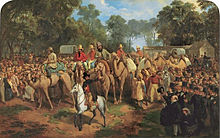 Nicholas Chevalier, Memorandum of the Start of the Exploring Expedition, oil on canvas, 1860, Art Gallery of South Australia
Nicholas Chevalier, Memorandum of the Start of the Exploring Expedition, oil on canvas, 1860, Art Gallery of South Australia
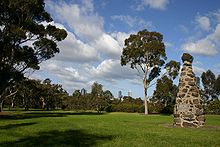 Monument in Royal Park, Melbourne where the expedition commenced
Monument in Royal Park, Melbourne where the expedition commenced
The expedition set off from Royal Park, Melbourne at about 4 pm on 20 August 1860 watched by around 15,000 spectators. The 19 men of the expedition included five Englishmen, six Irishmen, four Indian sepoys, three Germans and an American. They took twenty-three horses, six wagons and twenty-six camels.
The expedition took a large amount of equipment; including enough food to last two years, a cedar-topped oak camp table with two chairs, rockets, flags and a Chinese gong; the equipment all together weighed as much as 20 tonnes.[8] As committee member Captain Francis Cadell had opposed his appointment as leader of the expedition, Burke refused his offer to transport the supplies to Adelaide by ship and then up the Murray and Darling Rivers to be collected on the way, everything was instead loaded onto six wagons. One wagon broke down before it had even left Royal Park and by midnight of the first day the expedition had only reached Essendon on the edge of Melbourne. At Essendon two more wagons broke down. Heavy rains and bad roads made travelling through Victoria difficult and time-consuming. The party arrived at Lancefield on 23 August and set up their fourth camp. The first day off was taken on Sunday, 26 August 1860 at Camp VI in Mia Mia.
The expedition reached Swan Hill on 6 September 1860 and arrived in Balranald on 15 September 1860. There, to lighten the load, they left behind their sugar, lime juice and some of their guns and ammunition. At Gambala on 24 September, Burke decided to load some of the provisions onto the camels for the first time, and to lessen the burden on the horses ordered the men to walk. He also ordered personal luggage be restricted to 30 lb (14 kg). At Bilbarka on the Darling Burke and his second-in-command, Landells, argued after Burke decided to dump the 60 gallons (≈270 litres) of rum that Landells had brought to feed to the camels in the belief that it prevented scurvy. At Kinchega on the Darling, Landells resigned from the expedition, followed by the expedition's surgeon, Dr Hermann Beckler. Third-in-command Wills was promoted to second-in-command. They reached Menindee on 12 October having taken two months to travel 750 km (470 mi) from Melbourne - the regular mail coach did the journey in little more than a week. Two of the expedition's five officers had resigned, thirteen members of the expedition had been fired and eight new men had been hired.[6]
In July 1859 the South Australian government offered a reward of £2000 (about A$230,000 in 2003 dollars) for the first successful south-north crossing of the continent west of the 143rd line of longitude. The experienced explorer John McDouall Stuart had taken up the challenge. Burke was concerned Stuart might beat him to the north coast and he soon grew impatient with their slow progress often averaging only 2 mi (3.2 km) an hour. Burke split the group, taking the strongest horses, seven of the fittest men and a small amount of equipment, with plans to push on quickly to Cooper Creek and then wait for the others to catch up. They left Menindee on 19 October, guided by William Wright who was appointed third-in-command. Travel was relatively easy because recent rain made water abundant while unusually mild weather saw temperatures exceed 90 °F (32 °C) only twice before reaching Cooper Creek. At Torowotto Swamp Wright was sent back to Menindee alone to bring up the remainder of the men and supplies and Burke continued on to Cooper Creek.
Cooper Creek
In 1860 Cooper Creek was the edge of the land that had been explored by Europeans, the river having been visited by Captain Charles Sturt in 1845 and Augustus Charles Gregory in 1858. Burke arrived at the Cooper on 11 November and they formed a depôt at Camp LXIII (Camp 63) while they conducted reconnaissance to the north. A plague of rats forced the men to move camp and they formed a second depôt further downstream at Bullah Bullah Waterhole. This was Camp LXV (Camp 65) and they erected a stockade and named the place Fort Wills.
It was thought that Burke would wait at Cooper Creek until autumn (March the next year) so they would avoid having to travel during the hot Australian summer. However, Burke only waited until Sunday, 16 December before deciding to make a dash for the Gulf of Carpentaria. He split the group again, leaving William Brahe in charge of the depôt, with Dost Mahomet, William Patton and Thomas McDonough. Burke, Wills, John King and Charles Gray set off for the Gulf with six camels, one horse and enough food for just three months. By now it was mid-summer and the daily temperature often reached 122 °F (50 °C) in the shade, and in the Strzelecki and Sturt Stony Deserts there was very little shade to be found. Brahe was ordered by Burke to wait for three months; Wills, however, secretly instructed him to extend it to four months.
The Gulf of Carpentaria
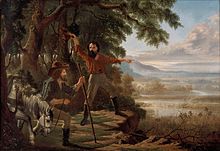 Edward Jukes Greig, Arrival of Burke & Wills at Flinders River, oil on canvas, 1862, State Library of New South Wales
Edward Jukes Greig, Arrival of Burke & Wills at Flinders River, oil on canvas, 1862, State Library of New South Wales
Except for the heat, travel was easy. As a result of recent rains water was still easy to find and the Aborigines, contrary to expectations, were peaceful. On 9 February 1861 they reached the Little Bynoe River, an arm of the Flinders River delta where they found they could not reach the ocean because of the mangrove swamps in their way. Burke and Wills left the camels behind with King and Gray at Camp CXIX (Camp 119), and set off through the swamps, although after 24 km (15 mi) they decided to turn back. By this stage, they were desperately short of supplies. They had food left for 27 days, but it had already taken them 59 days to travel from Cooper Creek.
On their way north, the weather had been hot and dry, but on the way back the wet season broke and the tropical monsoonal rains began. A camel named Golah Sing was abandoned on 4 March when it was unable to continue. Three other camels were shot and eaten along the way and they shot their only horse, Billy, on 10 April on the Diamantina River, south of what is today the town of Birdsville. Equipment was abandoned at a number of locations as the number of pack animals was reduced. One of these locations, Return Camp 32, was relocated in 1994 and The Burke and Wills Historical Society[9] mounted an expedition to verify the discovery of camel bones in 2005.
To extend their food supply, they ate portulaca, Gray also caught an 11 lb (5.0 kg) Python (probably Aspidites melanocephalus, a black-headed python), which they ate. Both Burke and Gray immediately came down with dysentery. Gray was ill, but Burke thought he was "gammoning" (pretending). On 25 March on the Burke River (just south of what is now the town of Boulia), Gray was caught stealing skilligolee (a type of watery porridge) and Burke beat him. By 8 April Gray could not walk; he died on 17 April of dysentery at a place they called Polygonum Swamp. The location of Gray's death is unknown, although it is generally believed to be Lake Massacre in South Australia. While the possibility that Burke killed Gray has been discounted, the severity of the beating Burke gave has been widely debated. The three surviving men stopped for a day to bury Gray, and to recover their strength – they were by this stage very weak from hunger and exhaustion. They finally reached Cooper Creek on 21 April only to find the camp had been abandoned several hours earlier.
Return to Cooper Creek
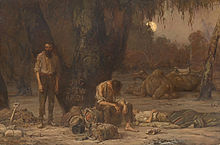 John Longstaff, Arrival of Burke, Wills and King at the deserted camp at Cooper's Creek, Sunday evening, 21 April 1861, oil on canvas, 1907, National Gallery of Victoria
John Longstaff, Arrival of Burke, Wills and King at the deserted camp at Cooper's Creek, Sunday evening, 21 April 1861, oil on canvas, 1907, National Gallery of Victoria
Burke had asked Brahe and the depôt party to remain at the camp on the Cooper for 13 weeks. The party actually waited for 18 weeks and was running low on supplies and starting to feel the effects of scurvy; they had come to believe that Burke would never return from the gulf. After one of his men had injured his leg, Brahe decided to return to Menindee, but before leaving buried some provisions in case Burke did return, and blazed (cut or carved) a message on a tree to mark the spot.
Brahe left the depôt on Cooper Creek on Sunday, 21 April 1861. Burke, Wills and King returned that evening. Finding the camp deserted, they dug up the cache of supplies, and a letter explaining that the party had given up waiting and had left only that morning. Burke's team had missed them by only nine hours. The three men and two remaining camels were exhausted; they had no hope of catching up to the main party.
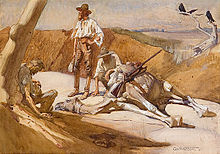 George Washington Lambert, Burke and Wills on the way to Mount Hopeless, watercolour, 1907, Bendigo Art Gallery
George Washington Lambert, Burke and Wills on the way to Mount Hopeless, watercolour, 1907, Bendigo Art Gallery
They decided to rest and recuperate, living off the supplies left in the cache. Wills and King wanted to follow their outward track back to Menindee, but Burke overruled them and decided to attempt to reach the furthest outpost of pastoral settlement in South Australia, a cattle station near Mount Hopeless. This would mean travelling southwest through the desert for 240 kilometres (150 mi). They wrote a letter explaining their intentions and reburied it in the cache under the marked tree in case a rescue party visited the area. Unfortunately, they did not change the mark on the tree or alter the date. On 23 April they set off, following the Cooper downstream and then heading out into the Strzelecki Desert towards Mount Hopeless.
Meanwhile, while returning to Menindee, Brahe had met with Wright trying to reach the Cooper with the supplies. The two men decided to go back to Cooper Creek to see if Burke had returned. When they arrived on Sunday, 8 May, Burke had already left for Mount Hopeless, and the camp was again deserted. Burke and Wills were 35 miles (56 km) away by this point. As the mark and date on the tree were unaltered, Brahe and Wright assumed that Burke had not returned, and did not think to check to see if the supplies were still buried. They left to rejoin the main party and return to Menindee.
Controversy
Brahe may have stayed at Cooper Creek longer but one of his men, the blacksmith Patton, had injured his leg after being thrown from his horse and they decided to leave for Menindee that morning. Patton was to die from complications six weeks later. Burke and Wills discussed catching up with them, but they were too exhausted and decided to wait.
Meanwhile, the other mission led by William Wright was having terrible problems of its own. Wright was supposed to bring supplies up from Menindee to Cooper Creek, but it was the end of January 1861 before he managed to set out from Menindee. Wright's delay subsequently resulted in him being blamed for the deaths of Burke and Wills. Alan Moorehead wrote of the 'mystery' surrounding Wright's delay;
- "There was no basis here for criminal proceedings against Wright, but he had been publicly condemned as the man on whom the guilt chiefly lay, and that was a reputation that he was unlikely ever to lie down. He retired to obscurity in Adelaide, leaving behind him still a slight, persistent mystery: why had he really delayed? Was it only because he wanted to make sure of his salary? Was it because he did not want to leave his wife and family and the comforts of the settled districts? Was it merely that he was stupid, lazy and indifferent: a man too mean-spirited to think of anyone but himself? Or was it just possible that he was the victim of that same fated chain of errors that had bedevilled the expedition from the beginning? These were questions that would never be fully answered." Cooper's Creek, p. 192.
An in-depth study of Wright's action formed a part of Dr Tom Bergin's 1982 MA thesis at the University of New England. Dr Bergin showed a lack of money and too few pack animals to carry the supplies meant Wright was placed in an unenviable position. His requests to the Exploration Committee were not acted on until early January, by which time the hot weather and lack of water meant the party moved incredibly slowly. They were harassed by the Bandjigali and Karenggapa Murris, and three of the men, Dr Ludwig Becker, Charles Stone and William Purcell, died from malnutrition on the trip. On his way north, Wright camped at Koorliatto Waterhole on the Bulloo River while he tried to find Burke's tracks to Cooper Creek. While he was there he met Brahe who was on his way back from the Cooper to Menindee.
The Dig Tree
The tree at the depôt camp that Brahe blazed to mark the location of the buried supplies on the banks of Bullah Bullah Waterhole on Cooper Creek in south-west Queensland is a coolibah, (Eucalyptus coolibah formerly Eucalyptus microtheca) estimated to be around 250 years old. Initially the tree was known as "Brahe's Tree" or the "Depôt Tree" and the tree under which Burke died attracted most attention and interest. As a result of the blaze on the tree and the subsequent popularity of the book "Dig" written in 1935 by Frank Clune, the tree became known as the "Dig Tree". There are three separate blazes on the tree; the camp number, a date blaze and the instruction to dig. Two of the blazes have grown closed and only the camp number blaze remains visible today.
The date blaze indicated the date of arrival and the date of departure "DEC-6-60" carved over "APR-21-61". The camp number blaze shows the initial "B" (for Burke) carved over the Roman numerals for (camp) 65; "B" over "LXV". The exact "DIG" inscription that Brahe carved is not known. It is variously recalled to be "DIG under" or "DIG 3 feet (0.91 m) N.W." or "DIG 40 feet (12 m) N.E." or "DIG 21 APR 61" or a combination of these.
In 1899 John Dick carved a likeness of Burke's face in a nearby tree along with his initials, his wife's initials and the date.
Burke, Wills and King alone at Cooper Creek
After leaving the Dig Tree they rarely travelled more than 5 mi (8.0 km) a day. One of the two remaining camels, Landa, became bogged in Minkie Waterhole and the other, Rajah was shot when he could travel no further. Without pack animals, Burke, Wills and King were unable to carry enough water to leave Cooper Creek and cross the Strzelecki Desert to Mount Hopeless, and so the three men were unable to leave the creek. Their supplies were running low, they were malnourished and exhausted. The Cooper Creek Aborigines, the Yandruwandha people, gave them fish, beans called 'padlu' and a type of damper made from the ground sporocarps of the ngardu (nardoo) plant (Marsilea drummondii) in exchange for sugar.
At the end of May 1861, Wills returned to the Dig Tree to put his diary, notebook and journals in the cache for safekeeping. Burke bitterly criticised Brahe in his journal for not leaving behind any supplies or animals. While Wills was away from camp, Burke foolishly shot his pistol at one of the Aborigines, causing the whole group to flee. Within a month of the Aborigines' departure, Burke and Wills both perished.[10]
Death
Towards the end of June 1861 as the three men were following the Cooper upstream to find the Yandruwandha campsite, Wills became too weak to continue. He was left behind at his own insistence at Breerily Waterhole with some food, water and shelter. Burke and King continued upstream for another two days until Burke became too weak to continue. The next morning Burke died. King stayed with his body for two days and then returned downstream to Breerily Waterhole, where he found that Wills had died as well.
The exact date that Burke and Wills died is unknown and different dates are given on various memorials in Victoria. The Exploration Committee fixed 28 June 1861 as the date both explorers died. King found a mob of Yandruwandha willing to give him food and shelter and in return he shot birds to contribute to their supplies.
Rescue Expeditions
In all, six expeditions were sent to search for Burkes and Wills, two commissioned by the Exploration Committee,[citation needed] three by the Royal Society of Victoria[citation needed] and one by the Government of South Australia. Two went by sea in order to search the Gulf of Carpentaria[citation needed] for the missing expedition while the others began their search from different directions.
Victorian Relief Expedition
After six months without receiving word from the Burke expedition, the media began questioning its whereabouts. Public pressure for answers increased and on 13 June 1861, the Exploration Committee agreed to send a search party to find the Burke and Wills expedition and, if necessary, offer them support. The Victorian Relief Expedition[citation needed] left Melbourne on 26 June 1861 under the leadership of Alfred William Howitt. At the Loddon River Howitt met Brahé who was returning from Cooper Creek. As Brahé did not have knowledge of Burke’s whereabouts, Howitt decided a much larger expedition would be required to find the missing party. Leaving three of his men at the river, Howitt returned to Melbourne with Brahé to update the Exploration Committee. On 30 June the expanded expedition left to follow Burke’s trail. On 3 September the party reached the Cooper Creek,[citation needed] on 11 September the Dig Tree and four days later found King living with the Yandruwandha. Over the next nine days Howitt found the remains of Burke and Wills and buried them. In pitiful condition, King survived the two-month trip back to Melbourne, and died eleven years later, aged 33, having never recovered his health. He is buried in the Melbourne General Cemetery.
HMVS Victoria
On 4 August 1861, the HMCSS Victoria under the Command of William Henry Norman sailed from Hobson's Bay in Victoria with orders to search the Gulf of Carpentaria. Arriving in Brisbane on 24 August, the Queensland Relief Expedition boarded.[citation needed] The Victoria arrived at the Albert River in the Gulf at the end of September 1861. After finding traces of the explorers,[citation needed] the Queensland Relief Expedition disembarked and the vessel returned to Melbourne.
Queensland Relief Expedition
After disembarking from the Victoria in November, the Queensland Relief Expedition under the leadership of William Landsborough searched the gulf coast[citation needed] for the missing expedition. Later it turned south and continued until it arrived in Melbourne in October 1862. Having crossed Australia from north to south, the expedition was awarded the £2000 prize for the first successful crossing of the continent.[citation needed]
Victorian Relief Expedition
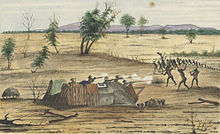 William Hodgkinson, Bulla, Queensland, watercolour, 1861, National Library of Australia. Hodgkinson briefly joined the Burke and Wills expedition at Swan Hill, and was a member of two relief expeditions. Bulla depicts the Victorian Relief Expedition in armed conflict with Bulloo Aborigines.
William Hodgkinson, Bulla, Queensland, watercolour, 1861, National Library of Australia. Hodgkinson briefly joined the Burke and Wills expedition at Swan Hill, and was a member of two relief expeditions. Bulla depicts the Victorian Relief Expedition in armed conflict with Bulloo Aborigines.
Frederick Walker led the Victorian Relief Expedition. The party, consisting of twelve mounted men,[citation needed] seven of them ex-troopers from the Native Police Corps, started from Rockhampton on 7 September 1861 with the goal of reaching the Gulf of Carpentaria. They found traces of Burke and followed them to Burke’s northernmost Camp but lost the trail from there. On 4 December they came across a group of Aborigines, killing 12 in the fight that ensued. On 7 December, Walker met up with the HMVS Victoria in the Gulf. Walker’s party went on to explore much of the Gulf region.
South Australian Burke Relief Expedition
The South Australian House of Assembly chose John McKinlay to lead the South Australian relief expedition that left Adelaide on 16 August 1861. On 20 October the grave of a European, thought to be Charles Gray, was found at Polygonum Swamp near Cooper Creek. Finding another grave nearby McKinlay assumed the Burke expedition had been killed there and he named the site Massacre Lake. Learning that Howitt had found the remains of Burke and Wills, McKinlay decided to search in the direction of Central Mount Stuart but was driven back by heavy rains and floods. McKinlay then made for the Gulf of Carpentaria, hoping to find the HMVS Victoria still there. By 20 May 1862, McKinlay was around five miles (8 km) from the shore of the Gulf, but the intervening country was found to be impassable and he decided to turn east and make for Port Denison on the north Queensland coast. On 2 August 1862, McKinlay reached a station on the Bowen River near Port Denison and after resting a few days the expedition reached Port Denison. The party then returned by sea to Adelaide. McKinlay received a grant of £1000 from the government and a gold watch from the Royal Geographical Society of England.
Victorian Exploration Party
The Victorian Exploration Party was the second expedition under the guidance of Alfred Howitt and was tasked with returning Burke and Wills' remains to Melbourne. On 9 December 1861 Howitt left Melbourne for Cooper Creek. After a long stay in Menindee and again at Mount Murchison the party arrived at Cooper Creek on 25 February 1862, camping at Cullyamurra waterhole. From there Howitt undertook numerous exploratory trips into the surrounding area. On 13 April 1862, Burke's and Wills' remains were exhumed.[11]
For the next six months Howitt explored the Australian interior before deciding in November to return to the settled areas.[12] On 8 December the party arrived in Clare, South Australia. Howitt and the expedition's doctor continued on to Adelaide while the rest of the expedition members followed three days later by train. Burke's and Wills' remains were then taken to Melbourne, arriving on 29 December 1862.
Presentation to the Yandruwandha
Breastplates were issued to Aboriginal people between 1815 and 1946 for faithful service, for saving the lives of non-Indigenous people and to recognise stockmen and trackers.[13] On this trip to exhume Burke and Wills' remains, Howitt presented three breastplates commissioned by the Victorian Exploration Committee to the Yandruwandha people in appreciation of the assistance they had given to Burke, Wills and King. One of these plates is in the collection of the National Museum of Australia. The inscription on the plate states that it was presented "for the Humanity shewn to the Explorers Burke, Wills and King 1861".[14]
Cause of death[15]
Unbeknown to the explorers, ngardu sporocarps contain thiaminase which depletes the body of vitamin B1 (thiamin). It is probable that they were not preparing the seedcakes in accordance with Aboriginal food preparation methods, as the food was a staple among the local people. It has been argued that they did not make the food into the requisite paste to begin with, which might have nullified the deleterious effects they suffered.[16] Despite eating the men got weaker and weaker. Wills wrote in his diary:
"My pulse is at 48 and very weak and my legs and arms are nearly skin and bone. I can only look out like Mr Micawber for something to turn up, but starvation on nardoo is by no means unpleasant, but for the weakness one feels, and the utter inability to move oneself, for as the appetite is concerned, it gives me the greatest satisfaction."
As a result, it is likely that the deaths of Burke and Wills resulted in part from a thiamin deficiency called Beriberi. Evidence to this effect is further provided by King's account, which revealed that Burke complained of leg and back pain shortly before his death.
Cooper Creek summary
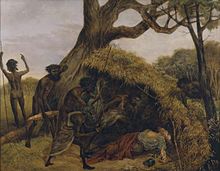 Eugene Montagu Scott, Natives discovering the body of William John Wills, the explorer, at Coopers Creek, June 1861, oil on canvas, 1862, State Library of Victoria
Eugene Montagu Scott, Natives discovering the body of William John Wills, the explorer, at Coopers Creek, June 1861, oil on canvas, 1862, State Library of Victoria
- 11 November 1860. Burke, Wills, King, Gray, Brahe, Mahomet, Patton and McDonough made their first camp on what they thought was Cooper Creek, but which was actually the Wilson River. This was Camp LVII (Camp 57).
- 20 November 1860. The first Depôt Camp was established at Camp LXIII (Camp 63).
- 6 December 1860. The Depôt Camp was moved downstream to Camp LXV - The Dig Tree (Camp 65).
- 16 December 1860. Burke, Wills, King and Gray left the Depôt for the Gulf of Carpentaria.
- 16 December 1860 – 21 April 1861. Brahe is left in charge of the Depôt at Cooper Creek.
- 21 April 1861. Brahe buried a cache of supplies, carved a message in the Dig Tree and headed back to Menindee. Later that day, Burke, Wills and King returned from the Gulf to find the Depôt deserted.
- 23 April 1861. Burke, Wills and King followed the Cooper downstream heading towards Mount Hopeless in South Australia.
- 7 May 1861. The last camel, Rajah, died. The men cannot carry enough supplies to leave the creek.
- 8 May 1861. Brahe and Wright return to the Dig Tree. They stayed only 15 minutes and did not dig up Burke's note in the cache.
- 30 May 1861. Wills, having failed to reach Mount Hopeless, returned to the Dig Tree to bury his notebooks in the cache for safe-keeping.
- End of June/ early July 1861. Burke and Wills died.
- 11 September 1861. Howitt, leader of the Burke Relief Expedition arrived at the Dig Tree.
- 15 September 1861. Howitt found King the only survivor of the four men who reached the Gulf.
- 28 September 1861. Howitt dug up the cache at the 'Dig Tree' and recovered Wills' notebooks.
Deaths on the Victorian Exploring Expedition
- Charley Gray, Wednesday, 17 April 1861 at Polygonum Swamp.
- Charles Stone, Monday, 22 April 1861 at Koorliatto Waterhole, Bulloo River.
- William Purcell, Tuesday, 23 April 1861 at Koorliatto Waterhole, Bulloo River.
- Dr Ludwig Becker, Monday, 29 April 1861 at Koorliatto Waterhole, Bulloo River.
- William Patten, Wednesday, 5 June 1861 near Desolation Camp, Rat Point.
- William John Wills, the official date of death adopted by the Exploration Committee was Wednesday, 28 June 1861, but Wills probably died around Friday, 30 June or Saturday, 1 July 1861 at Breerily Waterhole, Cooper Creek.
- Robert O'Hara Burke, the official date of death adopted by the Exploration Committee was Wednesday, 28 June 1861, but Burke probably died on Saturday, 1 July 1861 at Burke's Waterhole, Cooper Creek.
Afterwards
The Victorian Government held a Commission of Enquiry into the deaths of Burke and Wills. Howitt was sent back to Cooper Creek to recover their bodies and the explorers were given a state funeral in Melbourne on Wednesday, 21 January 1863. The funeral car was modelled on the design used for the Duke of Wellington ten years earlier. There were reported to have been 40,000 spectators. Burke and Wills were buried at the Melbourne General Cemetery.
In some ways the tragic expedition was not a waste. It completed the picture of inland Australia, and proved that there was no inland sea. More importantly, each of the rescue parties sent from different parts of the continent added in some way to the understanding of the land it crossed.
In 1862 monuments were erected in Back Creek Cemetery, Bendigo, and also on the hill overlooking Castlemaine where Burke had been stationed before leading the expedition. The Victorian towns of Beechworth and Fryerstown also unveiled memorials. In 1867 Ballarat erected the Explorer's Fountain on Sturt and Lydiard Streets. Wills, his brother Tom and their father, Dr William Wills, had all lived in Ballarat.
In 1890 a monument was erected at Royal Park, the expedition's departure point in Melbourne. The plaque on the monument states:
- This memorial has been erected to mark the spot from whence the Burke and Wills Expedition started on 20 August 1860. After successfully accomplishing their mission the two brave leaders perished on their return journey at Coopers Creek in June 1861.
In 1983 they were honoured on a postage stamp depicting their portraits issued by Australia Post.[17] In August 2010 Australia Post will issue four stamps to commemorate the 150th anniversary.
In 1918 a silent movie, A Romance of Burke and Wills Expedition of 1860, was released. The plot is fictional and only loosely connected to the Burke and Wills expedition. In 1985 the film, Burke & Wills, was made with Jack Thompson as Burke, and Nigel Havers as Wills.
In November 2009 the Royal Australian Mint issued two coins, $1 and a 20 cent, to commemorate the 150th anniversary of the expedition.
See also
References
- ^ a b "Burke & Wills Web - an historical research resource". www.burkeandwills.net.au. 3 August 2010. http://www.burkeandwills.net.au/. Retrieved 2010-09-15.
- ^ Sadauskas, Andrew, "Burke and Wills' Courage and Folly", in Australian Stamps Professional, online at http://australianstampspro.com/burkeandwills/ Accessed 5/12/2010.
- ^ "The Exploration Committee: 1857". Burke and Wills Web, www.burkeandwills.net.au. http://www.burkeandwills.net.au/Royal_Society/Exploration_Committee/Exploration_Committee_1857.htm. Retrieved 2010-09-15.
- ^ "The Exploration Fund Raising Committee". Burke and Wills Web, www.burkeandwills.net.au. http://www.burkeandwills.net.au/Royal_Society/Exploration_Fund_Committee/Exploration_Fund_Raising_Committee.htm. Retrieved 2011-03-10.
- ^ "The Exploration Committee: 1860". Burke and Wills Web, www.burkeandwills.net.au. http://www.burkeandwills.net.au/Royal_Society/Exploration_Committee/Exploration_Committee_1860.htm. Retrieved 2010-09-15.
- ^ a b c Wright, Ed (2008). Lost Explorers. Murdock Books. ISBN 978 1 7419 6139 3.
- ^ "Camels & Sepoys for the Expedition". Burke and Wills Web, www.burkeandwills.net.au. http://www.burkeandwills.net.au/Camels/Camels_for_the_Expedition.htm. Retrieved 2010-09-15.
- ^ AAP. "The Bulletin publishes for the last time". Bulletin.ninemsn.com.au. http://bulletin.ninemsn.com.au/bulletin/EdDesk.nsf/0/561eeb20413f1e3eca256b110014ba20?OpenDocument. Retrieved 2010-09-15.
- ^ "The Burke and Wills Historical Society". www.burkeandwills.org. http://www.burkeandwills.org/. Retrieved 2010-09-15.
- ^ Diamond, Jared (2005). "Yali's People". Guns, Germs and Steel. W. W. Norton & Company. p. 296. ISBN 9780393061314.
- ^ The Victorian Exploring Party, 1862. Burke and Wills Web, www.burkeandwills.net.au. Retrieved 2011-04-04.
- ^ Alfred Howitt's despatch - Angepinna, 21 November 1862. Burke and Wills Web, www.burkeandwills.net.au. Retrieved 2011-04-04.
- ^ A history of Aboriginal Breastplates, National Museum of Australia, accessed 7 April 2011
- ^ Victorian Exploring Expedition breastplate, National Museum of Australia. Retrieved 2011-04-04.
- ^ Earl, J.; McCleary, B. (1994). "Mystery of the poisoned expedition". Nature 368 (6473): 683–684. Bibcode 1994Natur.368..683E. doi:10.1038/368683a0. PMID 8152477.
- ^ Chaffey, Calder (June 2002). "A Fern which Changed Australian History". Australian Plants online. Association of Societies for Growing Australian Plants. http://asgap.org.au/APOL26/jun02-6.html. Retrieved 2008-04-12.
- ^ http://www.australianstamp.com/images/large/0014580.jpg
Further reading
- Burke and Wills Web by Dave Phoenix
- The [Melbourne] Argus, 1861. "The Burke and Wills exploring expedition: An account of the crossing the continent of Australia from Cooper Creek to Carpentaria, with biographical sketches of Robert O'Hara Burke and William John Wills." Melbourne: Wilson and Mackinnon.
- Bergin, Thomas John, & Australian Broadcasting Corporation, 1981. In the steps of Burke and Wills. Sydney: Australian Broadcasting Commission. ISBN 0-642-97413-6.
- Bergin, Thomas John, & Readers Digest, 1996. Across the outback.. Surrey Hills: Readers Digest. ISBN 0-86449-019-4.
- Bonyhady, Tim, 1991. Burke and Wills: From Melbourne to myth. Balmain: David Ell Press. ISBN 0-908197-91-8.
- Burke and Wills Outback Conference 2003, 2005. The Inaugural Burke & Wills Outback Conference: Cloncurry 2003 : a collation of presentations. Cairns: Dave Phoenix. ISBN 0-646-44702-5
- Clarke, Manning, 1995. Manning Clark's History of Australia. London: Pimlico, Chapter 7: "Glory, Folly and Chance", pp. 281–295. ISBN 0-7126-6205-7.
- Clune, Frank, 1937. Dig: A drama of central Australia. Sydney: Angus and Robertson.
- Colwell, Max, 1971. The journey of Burke and Wills. Sydney: Paul Hamlyn. ISBN 0-600-04137-9.
- Corke, David G, 1996. The Burke and Wills Expedition: A study in evidence. Melbourne: Educational Media International. ISBN 0-909178-16-X.
- Ferguson, Charles D, 1888. Experiences of a Forty-Niner during the thirty-four years residence in California and Australia. Cleveland, Ohio: The Williams Publishing Co.
- Fitzpatrick, Kathleen, 1963. "The Burke and Wills Expedition and the Royal Society of Victoria." Historical Studies of Australia and New Zealand. Vol. 10 (No. 40), pp. 470–478.
- Judge, Joseph, & Scherschel, Joseph J, 1979. "First across Australia: The journey of Burke and Wills." National Geographic Magazine, Vol. 155, February 1979, pp. 152–191.
- Leahy, Frank, 2007. "Locating the 'Plant Camp' of the Burke and Wills expedition." Journal of Spatial Science, No. 2, December 2007, pp. 1–12.
- Moorehead, Alan McCrae, 1963. Coopers Creek. London: Hamish Hamilton.
- Murgatroyd, Sarah, 2002. The Dig Tree. Melbourne: Text Publishing. ISBN 1-877008-08-7.
- Phoenix, Dave, 2003. From Melbourne to the Gulf: A brief history of the VEE of 1860-1. Cairns: Self published.
- Van der Kiste, John, 2011. William John Wills: Pioneer of the Australian outback. Stroud: History Press. ISBN 978-0-7524-5855-7.
- Victoria: Parliament, 1862. Burke and Wills Commission. Report of the Commissioners appointed to enquire into and report upon the circumstances connected with the sufferings and death of Robert O'Hara Burke and William John Wills, the Victorian Explorers. Melbourne: John Ferres Government Printer.
- White, John, 1992. Burke and Wills: The stockade and the tree. Footscray, Vic: The Victoria University of Technology Library in association with Footprint Press.
External links
- Burke & Wills Web. A comprehensive online digital archive containing transcripts of many of the historical documents relating to the Burke & Wills Expedition.
- The Burke & Wills Historical Society.
- Dig: The Burke and Wills Research Gateway. The State Library of Victoria's online exhibition and resources.
- The Burke and Wills collection at the National Museum of Australia, Canberra.
- The Diary of William John Wills. The diary written by Wills while at the Cooper from 23 April 1861 to 28 June 1861, which is held at the National Library of Australia, Canberra.
- The Diary of William John Wills. Images of the diary at the National Library of Australia.
- The Burke and Wills picture trail. Images at Picture Australia.
- The Burke and Wills online collection at the State Library of New South Wales.
- The Royal Society of Victoria.
Categories:- 1860 in Australia
- 1861 in Australia
- History of Australia (1851–1900)
- Exploration of Australia
- History of Melbourne
Wikimedia Foundation. 2010.

